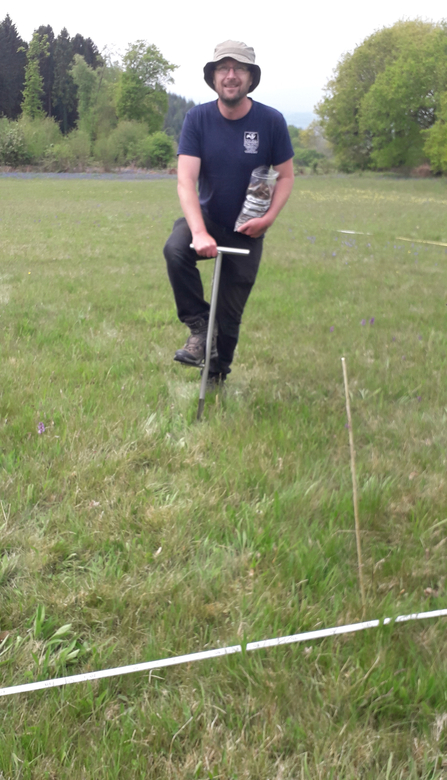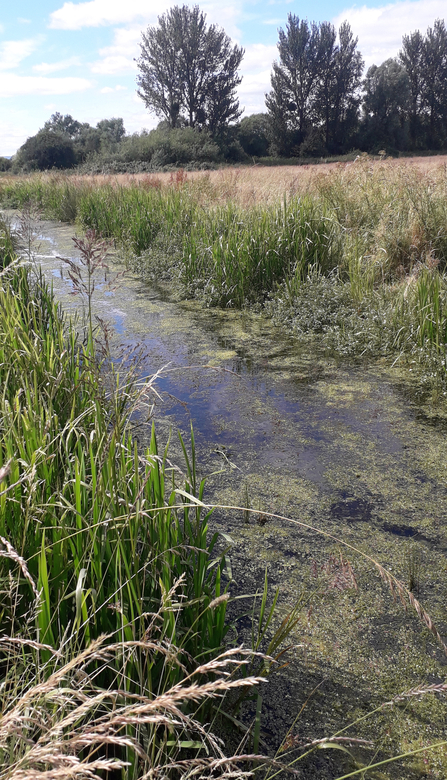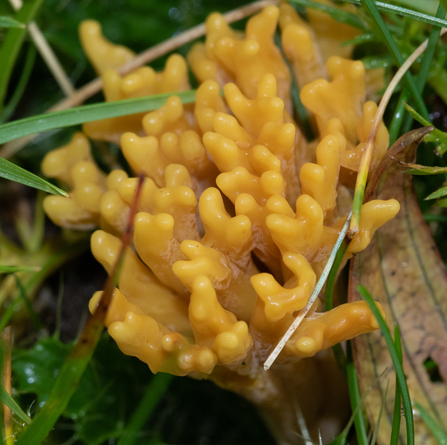
Peter Hunt
Evidence Manager Andy Karran collecting eDNA soil samples for analysis.
Andy Karran

Peter Hunt
Evidence Manager Andy Karran collecting eDNA soil samples for analysis.
Environmental DNA (eDNA) is genetic material that is obtained from environmental samples, such as soil, water, air, sediments and so on, or possibly from the remains of an animal, for example hair, droppings or dead bodies. eDNA is likely to be an increasingly important tool in undertaking ecological survey work into the future. It will never replace many more traditional survey methods, however, used in the right circumstances it can be very effective. We recognise we need to get the maximum value from our financial and staff resources to deliver the best value conservation work to protect our wildlife, as such these new, emerging technologies need to be explored and where applicable embraced.
Our eDNA work had two foci, Grassland Fungi and Invertebrates (water bugs) in the Reens (waterways) on the Gwent Levels. The two things these groups have in common is that they are great indicators of the health of the habitats they occupy, but also very difficult to identify unless you are a real expert, making them great candidates for eDNA work. Factor in that Grassland Fungi fruiting bodies are both unpredictable and ephemeral in showing themselves, then eDNA is a great survey method, although nothing beats actually seeing the beauty of the colourful fungi in the autumn.
With the invaluable help and pleasant company of our great volunteers, (thank you Peter Hunt, Claire Scawn and Julia Karran), and the kind permission of the landowners, we collected eDNA from 30 Grasslands (1,210 Soil core Samples) and 10 Reens on The Gwent Levels, (multiple water samples syringed through filters). These samples were then hurriedly sent by courier to the laboratories for analysis. Then we waited!
In September 2022, we got the results back; lots of obscure scientific names! A bit bewildering at first, however, the deeper we dug into the results the more interesting things we found. It would appear that species new to Wales and even the UK were detected!
Our Evidence Officer Lowri Watkins diligently sifted through the Reen Invertebrate results and produced a great report that can be viewed below
Some headlines are....
A total of 194 taxa were detected:
Taxa recorded as new to UK/Wales/Gwent are yet to be confirmed with specialist recording groups and are based on record searches of Aderyn and NBN only.
We also, just as importantly, found limitations to the survey, with hard bodied invertebrates, such as beetles shedding less eDNA, so perhaps being underestimated in the results. And the sampling took place mid-water, therefore perhaps missing species in the silt. Additionally, better data would be revealed by sampling a greater number of sites and repeating this as a form of monitoring; and that is indeed our ambition for the future.
This pilot study has demonstrated the great potential and with more funding and ever- improving eDNA technology, this could be a valuable method of monitoring the health of the vitally important, but threatened Gwent Levels.

Andy Karran
One of the sampled reens (waterway) on the Levels .
With the much-appreciated help of experts at Aberystwyth University, (who did the lab work) we tackled the wealth of information produced. The full report can be viewed below
Across the 30 sites a hugely impressive 100 CHEGD* Fungi species were detected.
*CHEGD stands for the first letter of the 5 key fungi groups involved in this assessment and is a standard, recognised way to assess the value of Grassland Fungi sites:
Clavarioids (spindles, club and coral fungi)
Hygrocybe (although recent DNA work has split this up) genus (Waxcaps)
Entoloma (pinkgills)
Geoglossum (earthtongues and relatives)
Dermoloma (Crazed caps and relatives)
Some sites alone had over 40 of these, just within the 30mx30m survey quadrat. This included 18 species that are assessed as “Vulnerable”*.
*IUCN (International Union for Conservation of Nature) Vulnerable – IUCN Criteria suggest that best available evidence indicates that it is facing a high risk of extinction in the wild.
Some of the sites we surveyed were known excellent Grassland Fungi sites and we were able to compare “traditional” and eDNA Survey results, with which the eDNA compared very favourably. At other sites their value was previously unknown, so we have discovered many new important Grassland Fungi sites and made the owners aware of their value, how to care for them and hopefully ignited an enthusiasm. Furthermore, by surveying a less favourable site immediately adjacent a known fantastic fungi site we have demonstrated just how long it can take for Grassland Fungi to colonise sites and therefore how important it is to preserve those in existence.
As well as the fungi, the eDNA was able to identify the grasses and wildflowers present which was a useful and interesting bonus survey result. Whilst this is no substitute, both scientifically and as an experience of surveying the flora conventionally, it did highlight a few species not previously recorded at sites and certainly would provide a great indication that a site is species-rich and worthy of further survey work.

Andy Karran
Meadow coral
We can conclude that the eDNA surveys were certainly interesting and more importantly useful towards our work. We will be hoping to do more in the future if funding can be secured. Further Invertebrate work on The Levels would be fantastic and we also aspire to carry out eDNA work on Dung Beetles.
This project has received funding through the Welsh Government Rural Communities - Rural Development Programme 2014-2020, which is funded by the European Agricultural Fund for Rural Development and the Welsh Government.
Cyllidwyd y prosiect hwn drwy Cymunedau Gwledig Llywodraeth Cymru - Rhaglen Datblygu Gwledig Cymru 2014-2020, a ariennir gan Lywodraeth Cymru a’r Gronfa Amaethyddol Ewrop ar gyfer Datblygu Gwledig.
